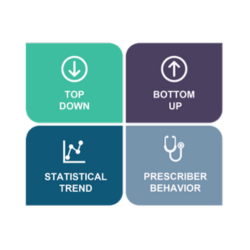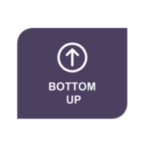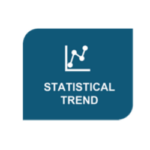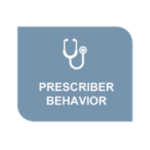Thomas Ross, MBA
Executive Director, Commercial Strategy, Mirador Global
Developing a robust, data-driven, defensible forecast provides not only a solid foundation for communicating the value of your product internally and with external partners but also promotes strategic dialog within the team. Thus far in our series on pharmaceutical product forecasting, we reviewed how the forecasting process can serve as the backbone to important strategic thinking and issues specific to forecasting products in the pre-launch phases of their lifecycle. For this third edition, we will dive a bit deeper into a few approaches for developing a pharmaceutical product forecast, the pros and cons, and when and why each may be an appropriate choice.
Considerations for selecting a forecasting approach include the characteristics of the asset, the resources available and the purpose and objectives of the forecast. For example, products earlier in the lifecycle may have less detail and more variability in the product profile, customer targets, or competitive environment, while products in early launch may have some Rx performance data to incorporate. Market characteristics like provider and patient volume, prescribing specialty, competitive landscape, disease area, and course of treatment can all inform the forecasting approach.
Another important consideration is the availability of data to support your forecast assumptions or to use as a basis for your forecast. Have you purchased secondary prescription or claims data, syndicated analysis, or conducted primary research? While these sources require additional investment, they add credibility to the forecast and, in the case of secondary data and primary research, can be tailored to your product and market. If these sources are not available to you, a desk-top survey of publications can provide you with a suitable foundation for building your forecast.
While designing your forecast approach, catalog the inputs available, the additional information that you can obtain, how the forecast will be used, and who will be the primary and secondary audiences.

There are many approaches to pharmaceutical forecasting, and they are often combined into hybrid approaches to meet the requirements of an organization. The 4 broad categories outlined here can cover many of the situations faced by your organization. There are pros and cons to each approach; some are more resource intensive and provide greater depth, while others have faster turnaround and provide enough insight to make decisions and enable valuable strategic dialogue.


Early in the product lifecycle many organizations lack secondary data or primary research to underpin a thorough forecast; looking for information on similar products can help to inform your forecast. Similar products could be existing drugs used to treat the same disease, drugs in other therapeutic areas but prescribed by the same specialty, or products with similar market access or administration methods. The biggest advantage to this approach is readily accessible information. Conducting a rigorous search and review of publicly available documents will produce necessary information to inform your forecast. Typically, the initial search and resulting insights will help you to narrow your scope and focus on strategically relevant forecast drivers. The drawback of this approach can be lack of specificity to your particular product or situation. The value of looking for analog products and reviewing relevant publications will largely rest on the forecaster’s ability to stitch together a compelling and wellsupported narrative. In the current environment, some well-crafted prompts to ChatGPT or Copilot could efficiently plot the course to a better understanding of the relevant issues to include in the forecast.

A second approach to building a forecast is to create a model “from the bottom up” using data and assumptions quantifying your market. This model may start with the relevant population of your market, adults 18 years and older for example. You then may apply the incidence (or prevalence) rate of the disease, rate of diagnosis, lines of treatment, payer coverage, etc. and eventually assumptions for market share achievement resulting in a demand forecast. As mentioned in the previous whitepaper, a common pitfall is to build a model that is too detailed, reducing the size of the opportunity with each layer.
An extension of the “bottom up” or epi method is to create a patient flow model. With this approach you model cohorts of patients as they initiate and continue treatment for a period of time. The patient flow model typically requires working in monthly increments as opposed to annual or quarterly periods typical of forecasts in the early stage of product development. The patient flow approach allows for modeling patient compliance (adherence to dosing and persistent use of the product over time) which can stimulate valuable strategic discussion among key stakeholders. The challenges of the “bottom up” model is managing the complexity of the model both in terms of the impact on the forecast (more assumptions typically equal lower forecasts) as well as the resources needed to build and maintain the model.
This approach is most beneficial to teams within 12-18 months of launch as it builds detailed understanding of the market dynamics, and post launch it provides sufficient detail until actual performance data can be used as the basis for the forecast.

Later in the product launch, when prescribing data is available, trends have been established and the market is well known, using a statistical approach to forecasting can be more efficient. Choosing the appropriate metric, such as total prescriptions or new prescriptions, will be dependent on the brand and market. by payer channel (Commercial, Medicare, Medicaid) again depending on your situation.
In addition to using statistical trends for the forecast, incorporating the impact of brand and market events will add additional insight to your forecast. Examples could be new market entrants, expanded label indications, brand or competitor loss of exclusivity or changes in payer coverage. These market events could expand or contract the market, move share from one product to another or change the gross to net sales ratio.
Another way to use a statistical approach and simplify your forecast is to model only your product and the overall market. This will allow you to still look at secondary measures like market share without the need to forecast every competitor in the market individually.

Up to this point we have focused on patients, patient treatment volume, and share. Another approach that can be effective at product launch or to provide checks and balances to your primary forecast is to model prescriber behavior. How many potential prescribers are there for your product? How many will you reach with your sales team or via other marketing channels? How often do they see the appropriate patients? With assumptions like these you can model how many prescribers trialed your product with patients and how many have “adopted” your product for regular use. This approach can also bring clarity to your sales team, “You need to get 2 prescribers to try product X per week to meet your sales target”. Modeling prescriber behavior gives you another perspective on your forecast, again driving good conversations among the brand team.
Forecasting a product can span a wide range of approaches and these methods can be combined or tailored to deliver the detail, accuracy, and outputs you need with the resources, market knowledge and information that you have. Moving from a forecast based on opinion and experience to one based on defensible, referenceable sources analyzed with a proven methodology will provide greater value to your organization in terms of both the outcomes of the forecast and the process of getting there.
In our next forecasting white paper, we will detail the Mirador Global process for forecasting early phase products. Until then, reach out to MIRADOR Global to shape the future value of your pharma asset and leverage your forecast to enable strategic conversations in your organization.

Executive Director, Commercial Strategy, MIRADOR Global
